
Islington is a district in the north of Greater London, England, and part of the London Borough of Islington. It is a mainly residential district of Inner London, extending from Islington's High Street to Highbury Fields, encompassing the area around the busy High Street, Upper Street, Essex Road, and Southgate Road to the east.

Islington was a civil parish and metropolitan borough in London, England. It was an ancient parish within the county of Middlesex, and formed part of The Metropolis from 1855. The parish was transferred to the County of London in 1889 and became a metropolitan borough in 1900. It was amalgamated with the Metropolitan Borough of Finsbury to form the London Borough of Islington in Greater London in 1965.

The New North Road is a road in northern central London, forming part of a link road from the A1 at Highbury into the City of London at Moorgate. It is 0.8 miles (1.3 km) in length and is part of the A1200. This link road consists of Canonbury Road and New North Road, before several smaller sections to the south leading into the city.

Liverpool Road is a street in Islington, North London. It covers a distance of 1+1⁄4 miles (2.0 km) between Islington High Street and Holloway Road, running roughly parallel to Upper Street through the area of Barnsbury. It contains several attractive terraces of Georgian houses and Victorian villas, many of which are listed buildings. There are a number of pubs, small businesses and restaurants along its route, as well as some secluded garden squares. The vast majority of the street is residential, with a bustling shopping and business area at the southern, Angel, end.

The London Borough of Islington is short of large parks and open spaces, given its status in recent decades as a desirable place of residence. In fact, Islington has the lowest ratio of open space to built-up areas of any London borough. The largest continuous open space in the borough, at 11.75 hectares, is Highbury Fields.
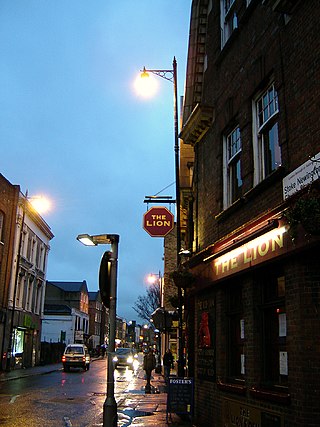
Stoke Newington Church Street is a road in north London of the borough of Hackney. The road links Green Lanes (A105) in the west to Stoke Newington High Street, in the east. Stoke Newington is one of the villages swallowed by the growth of London in the 19th century, and Church Street retains some of this neighbourhood feel, with many restaurants, pubs, and independent (non-chain) shops.

Lonsdale Square is a garden square in the Barnsbury district of Islington, North London. It is bounded by unusual Tudor Gothic Revival terraced houses, with picturesque gables and Elizabethan-style windows, and is probably unique among squares. All the houses are listed buildings. The central public garden contains flower beds and mature trees.
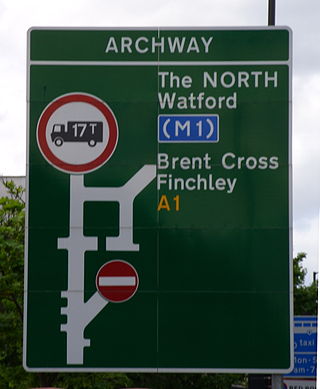
The A1 in London is the southern part of the A1 road. It starts at Aldersgate in the City of London, passing through the capital to Borehamwood on the northern fringe of Greater London, before continuing to Edinburgh. The road travels through the City and three London boroughs: Islington, Haringey and Barnet, which include the districts of Islington, Holloway, Highgate, Hendon and Mill Hill, and travels along Upper Street and Holloway Road, crossing the North Circular Road in Hendon, a district in the London Borough of Barnet.

Caledonian Road passes for about a mile and a half north–south through the London Borough of Islington. It connects North London, from Camden Road near its junction with Holloway Road, and central London's Pentonville Road in the south. It is known colloquially as the "Cally" and forms the entirety of the A5203.
Henry William Inwood was an English architect, archaeologist, classical scholar and writer. He was the joint architect, with his father William Inwood of St Pancras New Church.
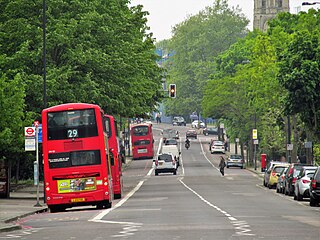
Camden Road is a main road in London running from the junction of Camden High Street and Camden Town Underground station up to Holloway Road. It is part of the A503 which continues east as Tollington Road.
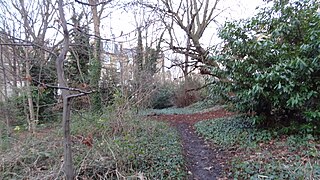
Barnsbury Wood is a Local Nature Reserve and Site of Borough Importance for Nature Conservation, Grade I, in Barnsbury in the London Borough of Islington. With an area of only 0.35 hectares, it is the smallest Local Nature Reserve in London It is owned and managed by Islington Council.

Canonbury Square is a garden square in Canonbury, North London. It is bounded by terraces of mostly Georgian houses, many of which are listed buildings. The central public gardens contain attractive flower beds and several London plane trees of great age. The Evening Standard newspaper described it in 1956 as “London’s most beautiful square”. Many significant figures from the arts and literary worlds have lived in the square, including George Orwell, Evelyn Waugh, Samuel Phelps, Duncan Grant and Vanessa Bell.

Canonbury Tower is a Tudor tower in Canonbury, and is the oldest building in Islington, North London. It is the most substantial remaining part of what used to be Canonbury House, erected for the Canons of St Bartholomew's Priory between 1509 and 1532. The tower has been occupied by many historical figures, including Sir Francis Bacon and Oliver Goldsmith. It is a Grade II* listed building, and is located in Canonbury Place, 100 metres (330 ft) east of Canonbury Square.
The Metropolitan Public Gardens Association is a charity in London for the purposes of the preservation of public parks and gardens, established in 1882. It facilitated the creation of new public open spaces, including from philanthropic landowners within its membership. The MPGA was involved in the formation and development of other amenity organisations. The charity still exists; in recent decades its emphasis has changed to smaller parcels of land and smaller projects within larger spaces, as well as to themed projects. The MPGA was the starting point for the careers of the ground-breaking female landscape gardeners Fanny Wilkinson and Madeline Agar.
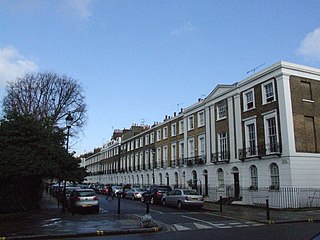
Gibson Square is a garden square in the Barnsbury district of Islington, North London. It is bounded by Regency and Victorian terraced houses, most of which are listed buildings. The central public gardens contain flower beds and mature trees, and an unusual building resembling a classical temple.

Milner Square is a garden square in the Barnsbury district of Islington, North London. It is bounded by early Victorian terraced houses, which are all listed buildings. Historic England describes it as "important for the radical logic of its design, of a type rarely seen outside Scotland and the North, and unlike anything in London."
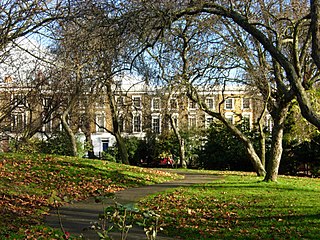
Thornhill Square together with the adjacent Thornhill Crescent form a garden square in the Barnsbury district of Islington, North London. It is bounded by Victorian terraced houses, all of which are listed buildings. The central public gardens contain flower beds, mature trees, and a children's play area, and the Crescent gardens surround the Victorian Church of St Andrew.

Cloudesley Square is a square in the Barnsbury district of Islington, North London. It is bounded by Georgian terraced houses, all of which are listed buildings. The central area is occupied by the Gothic Revival former Holy Trinity Church, designed by Charles Barry.
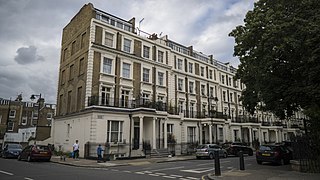
Arundel Square is a garden square in Barnsbury, North London. It is bounded on three sides by terraces of Victorian houses, and on the fourth with modern flats. The central public gardens contain mature trees, attractive flower beds and playground equipment.























